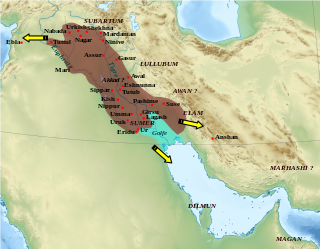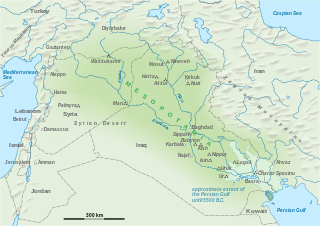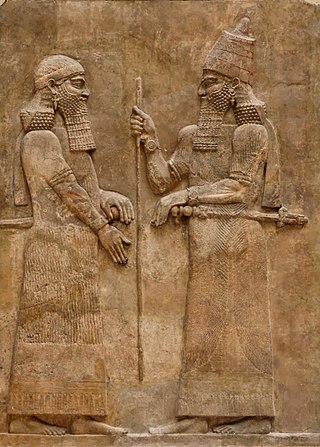
Armani was an ancient kingdom mentioned by Sargon of Akkad.

Armani was an ancient kingdom mentioned by Sargon of Akkad.
Syria:Armani was mentioned alongside Ibla in the geographical treaties of Sargon. This led some historians to identify Ibla with Syrian Ebla and Armani with Syrian Armi. [2]
Mesopotamia: Michael C. Astour refused to identify Armani with Armi, as Naram-Sin makes it clear that the Ibla he sacked (in c. 2240 BC) was a border town of the land of Armani, while the Armi in the Eblaite tablets is a vassal to Ebla.[ citation needed ]Armani was attested in the treaties of Sargon in a section that mentions regions located in Assyria and Babylonia or territories adjacent to the east, in contrast to the Syrian Ebla, located in the west. The later King Adad-Nirari I of Assyria also mentions Armani as being located east of the Tigris and on the border between Assyria and Babylon. [3] Historians who disagree with the identification of Akkadian Armani with Syrian Armi place it (along with Akkadian Ibla) north of the Hamrin Mountains in northern Iraq. [4]
When the God Dagon determined the verdict to Naram-Sin, the mighty God delivered into his hands Rid-Adad, king of Armanum and Naram-Sin personally captured him in the middle of his palace gateway.
—Naram-Sin describing his capture of the king of Armanum. [5]
First mentioned as the land of Armani by Sargon. During the Middle Assyrian and Kassite periods, the land of Armani was mentioned as located east of the Tigris. King Shalmaneser III mentions his conquest of Halman, but the identification of Halman with Akkadian Armani (Arman) is dubious according to J.A. Brinkmann. [3]

The Akkadian Empire was the first known ancient empire of Mesopotamia, succeeding the long-lived civilization of Sumer. Centered on the city of Akkad and its surrounding region, the empire united Akkadian and Sumerian speakers under one rule and exercised significant influence across Mesopotamia, the Levant, and Anatolia, sending military expeditions as far south as Dilmun and Magan in the Arabian Peninsula.

Babylonia was an ancient Akkadian-speaking state and cultural area based in the city of Babylon in central-southern Mesopotamia. It emerged as an Akkadian populated but Amorite-ruled state c. 1894 BC. During the reign of Hammurabi and afterwards, Babylonia was retrospectively called "the country of Akkad", a deliberate archaism in reference to the previous glory of the Akkadian Empire. It was often involved in rivalry with the older ethno-linguistically related state of Assyria in the north of Mesopotamia and Elam to the east in Ancient Iran. Babylonia briefly became the major power in the region after Hammurabi created a short-lived empire, succeeding the earlier Akkadian Empire, Third Dynasty of Ur, and Old Assyrian Empire. The Babylonian Empire rapidly fell apart after the death of Hammurabi and reverted to a small kingdom centered around the city of Babylon.

Ebla was one of the earliest kingdoms in Syria. Its remains constitute a tell located about 55 km (34 mi) southwest of Aleppo near the village of Mardikh. Ebla was an important center throughout the 3rd millennium BC and in the first half of the 2nd millennium BC. Its discovery proved the Levant was a center of ancient, centralized civilization equal to Egypt and Mesopotamia and ruled out the view that the latter two were the only important centers in the Near East during the Early Bronze Age. The first Eblaite kingdom has been described as the first recorded world power.
Adab was an ancient Sumerian city between Girsu and Nippur, lying about 35 kilometers southeast of the latter. It was located at the site of modern Bismaya or Bismya in the Al-Qādisiyyah Governorate of Iraq. The site was occupied at least as early as the 3rd Millenium BC, through the Early Dynastic, Akkadian Empire, and Ur III empire periods, into the Kassite period in the mid-2nd millennium BC. It is known that there were temples of Ninhursag/Digirmah, Iskur, Asgi, Inanna and Enki at Adab and that the city-god of Adab was Parag'ellilegarra (Panigingarra) "The Sovereign Appointed by Ellil".

Mari was an ancient Semitic city-state in modern-day Syria. Its remains form a tell 11 kilometers north-west of Abu Kamal on the Euphrates River western bank, some 120 kilometers southeast of Deir ez-Zor. It flourished as a trade center and hegemonic state between 2900 BC and 1759 BC. The city was built in the middle of the Euphrates trade routes between Sumer in the south and the Eblaite kingdom and the Levant in the west.

Naram-Sin, also transcribed Narām-Sîn or Naram-Suen, was a ruler of the Akkadian Empire, who reigned c. 2254–2218 BC, and was the third successor and grandson of King Sargon of Akkad. Under Naram-Sin the empire reached its maximum extent. He was the first Mesopotamian king known to have claimed divinity for himself, taking the title "God of Akkad", and the first to claim the title "King of the Four Quarters". He became the patron city god of Akkade as Enlil was in Nippur. His enduring fame resulted in later rulers, Naram-Sin of Eshnunna and Naram-Sin of Assyria as well as Naram-Sin of Uruk, assuming the name.

Shamshi-Adad, ruled c. 1808–1776 BC, was an Amorite warlord and conqueror who had conquered lands across much of Syria, Anatolia, and Upper Mesopotamia. His capital was originally at Ekallatum and later moved to Šubat-Enlil.

Išḫara was a goddess originally worshipped in Ebla and other nearby settlements in the north of modern Syria in the third millennium BCE. The origin of her name is disputed, and due to lack of evidence supporting Hurrian or Semitic etymologies it is sometimes assumed it might have originated in a linguistic substrate. In Ebla, she was considered the tutelary goddess of the royal family. An association between her and the city is preserved in a number of later sources from other sites as well. She was also associated with love, and in that role is attested further east in Mesopotamia as well. Multiple sources consider her the goddess of the institution of marriage, though she could be connected to erotic love as well, as evidenced by incantations. She was also linked to oaths and divination. She was associated with reptiles, especially mythical bašmu and ḫulmiẓẓu, and later on with scorpions as well, though it is not certain how this connection initially developed. In Mesopotamian art from the Kassite and Middle Babylonian periods she was only ever represented through her scorpion symbol rather than in anthropomorphic form. She was usually considered to be an unmarried and childless goddess, and she was associated with various deities in different time periods and locations. In Ebla, the middle Euphrates area and Mesopotamia she was closely connected with Ishtar due to their similar character, though they were not necessarily regarded as identical. In the Ur III period, Mesopotamians associated her with Dagan due to both of them being imported to Ur from the west. She was also linked to Ninkarrak. In Hurrian tradition she developed an association with Allani.

The Civilization of Mesopotamia ranges from the earliest human occupation in the Paleolithic period up to Late antiquity. This history is pieced together from evidence retrieved from archaeological excavations and, after the introduction of writing in the late 4th millennium BC, an increasing amount of historical sources. While in the Paleolithic and early Neolithic periods only parts of Upper Mesopotamia were occupied, the southern alluvium was settled during the late Neolithic period. Mesopotamia has been home to many of the oldest major civilizations, entering history from the Early Bronze Age, for which reason it is often called a cradle of civilization.
Prehistoric Armenia refers to the history of the region that would eventually be known as Armenia, covering the period of the earliest known human presence in the Armenian Highlands from the Lower Paleolithic more than 1 million years ago until the Iron Age and the emergence of Urartu in the 9th century BC, the end of which in the 6th century BC marks the beginning of Ancient Armenia.
Aram is a son of Shem, according to the Table of Nations in Genesis 10 of the Hebrew Bible, and the father of Uz, Hul, Gether and Mash or Meshech. The Book of Chronicles lists Aram, Uz, Hul, Gether, and Meshech as descendants of Shem, although without stating explicitly that Aram is the father of the other four.
Armänum, was a city-state in the ancient Near East whose location is still unknown. It was once thought to be in the same general area as Mari and Ebla. It is known from texts of the Akkadian period, during the reign of Naram-Sin of Akkad. There is a question of whether or not Armanum should be identified with Armi (Syria), that is also mentioned in many texts of this period. One proposed site of Armanum is Tall Bazi in Syria. According to Adelheid Otto, it was "... generally accepted that Armanum should be identified with Armi/Armium of the Ebla texts ...", as opposed to the site of Aleppo. In practice Armi and Armium were two different towns in the Ebla texts. Alfonso Archi disagreed with the attribution of the Akkadian Armanum to those towns of the north Syrian Ebla. Another analysis supports the view that the Ebla referred to by Naram-Sin is the Transtigridian Ebla and not the north Syrian Ebla.
Tuttul was an ancient Near East city. Tuttul is identified with the archaeological site of Tell Bi'a in Raqqa Governorate, Syria. Tell Bi'a is located near the modern city of Raqqa and at the confluence of the rivers Balikh and Euphrates.

Adad-šuma-iddina, inscribed mdIM-MU-SUM-na, and dated to around ca. 1222–1217 BC, was the 31st king of the 3rd or Kassite dynasty of Babylon and the country contemporarily known as Karduniaš. He reigned for 6 years some time during the period following the conquest of Babylonia by the Assyrian king, Tukulti-Ninurta I, and has been identified as a vassal king by several historians, a position which is not directly supported by any contemporary evidence.
Armi, was an important Bronze Age city-kingdom during the late third millennium BC located in northern Syria, or in southern Anatolia, Turkey, at the region of Cilicia.

Akkad was the capital of the Akkadian Empire, which was the dominant political force in Mesopotamia during a period of about 150 years in the last third of the 3rd millennium BC.

The timeline of ancient Assyria can be broken down into three main eras: the Old Assyrian period, Middle Assyrian Empire, and Neo-Assyrian Empire. Modern scholars typically also recognize an Early period preceding the Old Assyrian period and a post-imperial period succeeding the Neo-Assyrian period.

King of the Four Corners of the World, alternatively translated as King of the Four Quarters of the World, King of the Heaven's Four Corners or King of the Four Corners of the Universe and often shortened to simply King of the Four Corners, was a title of great prestige claimed by powerful monarchs in ancient Mesopotamia. Though the term "four corners of the world" does refer to specific geographical places within and near Mesopotamia itself, these places were thought to represent locations near the actual edges of the world and as such, the title should be interpreted as something equivalent to "King of all the known world", a claim to universal rule over the entire world and everything within it.

King of the Universe, also interpreted as King of Everything, King of the Totality, King of All or King of the World, was a title of great prestige claiming domination of the universe used by powerful monarchs in ancient Mesopotamia. The title is sometimes applied to God in the Abrahamic tradition.

Akkadian or Mesopotamian royal titulary refers to the royal titles and epithets assumed by monarchs in Ancient Mesopotamia from the Akkadian period to the fall of the Neo-Babylonian Empire, with some scant usage in the later Achaemenid and Seleucid periods. The titles and the order they were presented in varied from king to king, with similarities between kings usually being because of a king's explicit choice to align himself with a predecessor. Some titles, like the Akkadian šar kibrāt erbetti and šar kiššatim and the Neo-Sumerian šar māt Šumeri u Akkadi would remain in use for more than a thousand years through several different empires and others were only used by a single king.